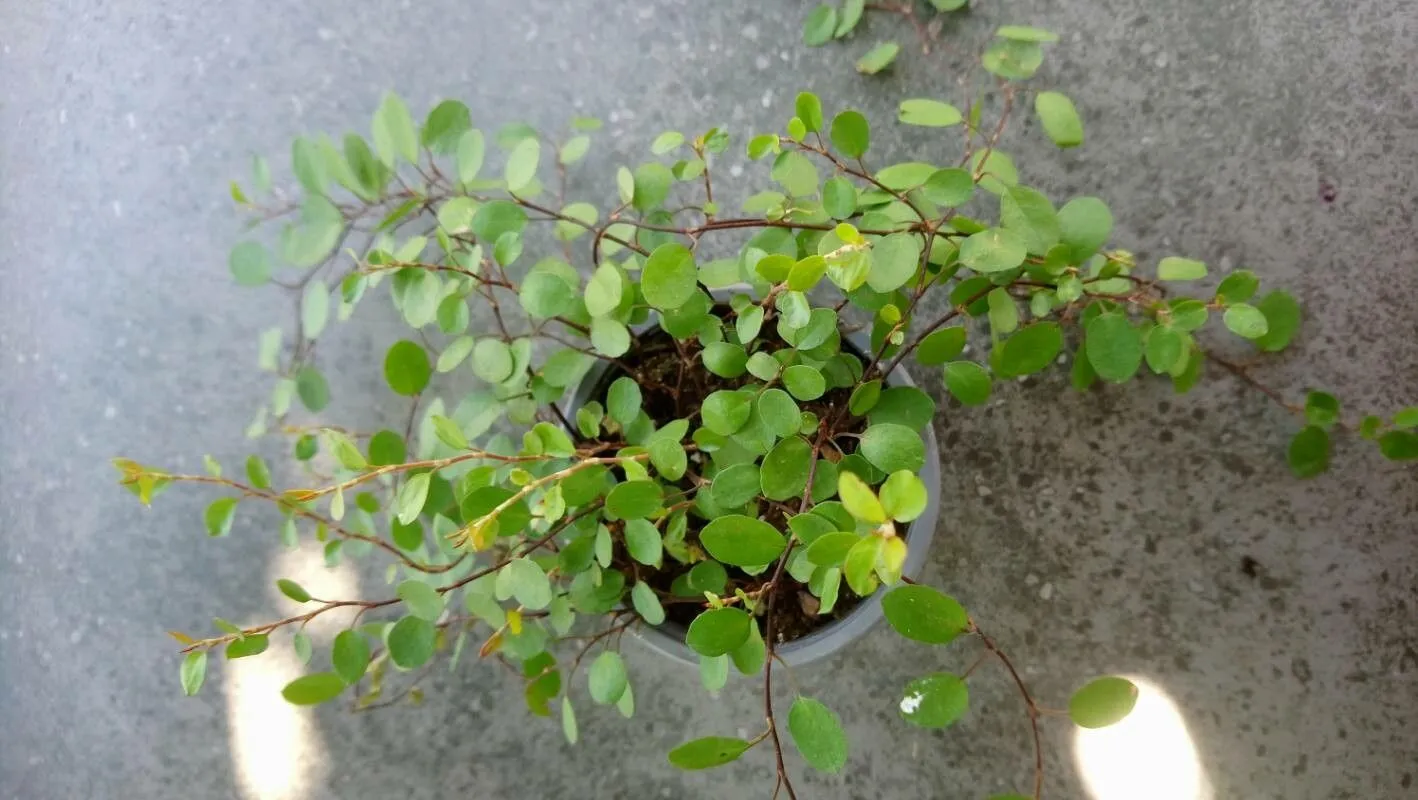
Author: (A.Cunn.) Meisn.
Bibliography: Pl. Vasc. Gen. 1: 227 (1839)
Year: 1839
Status: accepted
Rank: species
Genus: Muehlenbeckia
Vegetable: False
Observations: Lord Howe I. to New Zealand
The Maidenhair Vine, scientifically named Muehlenbeckia complexa, is a fascinating and resilient plant that belongs to the Polygonaceae family. Described in the botanical literature as early as 1839 by Meisner, who built upon the initial classification by A. Cunningham, this plant has captured the interest of botanists and gardening enthusiasts alike for its unique appearance and adaptability.
Native to the geographic range extending from Lord Howe Island to New Zealand, the Maidenhair Vine thrives in a variety of coastal and inland habitats. This versatile plant is particularly noted for its wiry, twining stems adorned with small, round leaves that form a delicate and intricate mat of greenery.
One of the key features of the Muehlenbeckia complexa is its dense foliage, which can create a lush, carpet-like effect, making it a popular choice for ground cover in gardens. The plant’s ability to grow both horizontally and vertically makes it ideal for use in a variety of landscaping applications, including as a covering for fences, trellises, and walls. Additionally, it can be used in container gardening to create a cascading effect over the sides of pots and hanging baskets.
The flowers of the Maidenhair Vine are small and not particularly showy, but they add a subtle charm to the plant with their delicate appearance. These flowers usually give way to small, black seeds, which can be propagated to grow new plants. The plant’s overall resilience and ease of care make it a favorite among those looking for low-maintenance greenery.
Given its hardiness and ability to withstand different growing conditions, the Maidenhair Vine is suited to both temperate and subtropical climates. Its adaptability means it can perform well in various soil types, provided they are well-draining. Moreover, the plant can endure periods of drought once established, though it will thrive best with regular watering during prolonged dry spells.
In summary, the Maidenhair Vine (Muehlenbeckia complexa) is a versatile and attractive plant that offers a wealth of landscaping possibilities. Whether used as ground cover, for vertical greening, or in container gardens, its lush foliage and resilience make it a valuable addition to a variety of garden settings.
Eng: maidenhair vine, wireplant, lacy wirevine, maidenhair-vine, mattressvine, wire plant
Por: cabelo-de-noiva
Swe: stor slideranka
Deu: weißfrüchtiger drahstrauch
Cym: llwyn gwifrau, llwyni gwifrau, llys y gwifrau
En: Maidenhair vine, Wireplant, Lacy wirevine, Maidenhair-vine, Mattressvine, Wire Plant
De: Weißfrüchtiger Drahstrauch
Pt: Cabelo-de-noiva
Sv: Stor slideranka
Cy: Llwyn Gwifrau, Llwyni Gwifrau, Llys y Gwifrau
Taken Nov 23, 2019 by V Angeliki (cc-by-sa)
Taken Nov 25, 2021 by Sylvette DIE PORTEMANN (cc-by-sa)
Taken May 13, 2019 by N SR (cc-by-sa)
Taken May 13, 2019 by N SR (cc-by-sa)
Taken Jun 2, 2022 by Stéphane Mars (cc-by-sa)
© copyright of the Board of Trustees of the Royal Botanic Gardens, Kew.
© copyright of the Board of Trustees of the Royal Botanic Gardens, Kew.
© copyright of the Board of Trustees of the Royal Botanic Gardens, Kew.
Taken Jun 8, 2021 by serpentinahermetica (cc-by-sa)
Taken Sep 25, 2021 by VASANTH offl (cc-by-sa)
Taken Aug 22, 2021 by iSMART GOPAL (cc-by-sa)
Taken Sep 27, 2022 by Fabrice Rubio (cc-by-sa)
Taken Nov 23, 2019 by V Angeliki (cc-by-sa)
Taken Dec 26, 2021 by Leen Nieuwenhuijse (cc-by-sa)
Taken Nov 29, 2021 by William Coville (cc-by-sa)
Taken May 28, 2022 by Trap Hers (cc-by-sa)
Taken Sep 27, 2022 by Fabrice Rubio (cc-by-sa)
Taken Jun 2, 2022 by Stéphane Mars (cc-by-sa)
Taken Feb 3, 2016 by EOL − Jon Sullivan (cc-by-nc)
Taken Sep 14, 2015 by EOL − Phil Bendle (cc-by-nc)
Taken Sep 15, 2019 by Renaud Brochiero (cc-by-sa)
Taken Sep 3, 2019 by Jean Beenard (cc-by-sa)
Taken Nov 1, 2018 by Filip Košić (cc-by-sa)
Taken Jan 1, 1900 by EOL − Howard, R.A. (cc-by-nc-sa)
Taken Apr 28, 2015 by EOL − Lisa Bennett (cc-by-nc)
Taken Jan 20, 2015 by EOL − Mike Lusk (cc-by-nc)
Taken Jan 19, 2015 by EOL − Tony Wills (cc-by-sa)
Taken Dec 16, 2021 by Almeida Cilene (cc-by-sa)
Growth habit>: Vine
Family: Myrtaceae Author: (F.Muell.) K.D.Hill & L.A.S.Johnson Bibliography: Telopea 6: 402 (1995) Year: 1995 Status:…
Family: Rubiaceae Author: Pierre ex A.Froehner Bibliography: Notizbl. Bot. Gart. Berlin-Dahlem 1: 237 (1897) Year:…
Family: Sapindaceae Author: Koidz. Bibliography: J. Coll. Sci. Imp. Univ. Tokyo 32(1): 38 (1911) Year:…
Family: Asteraceae Author: A.Gray Bibliography: Pacif. Railr. Rep.: 107 (1857) Year: 1857 Status: accepted Rank:…
Family: Fabaceae Author: Medik. Bibliography: Vorles. Churpfälz. Phys.-Ökon. Ges. 2: 398 (1787) Year: 1787 Status:…
Family: Aspleniaceae Author: (Cav.) Alston Bibliography: Bull. Misc. Inform. Kew 1932: 309 (1932) Year: 1932…